Safe natural preservatives for your green perfumes include citric acid, tea tree oil, rosemary extract, and organic sugar cane alcohol. You'll find these plant-based ingredients effectively prevent bacterial growth while maintaining fragrance integrity. For best results, combine multiple natural preservatives and store your perfumes in dark glass bottles at stable temperatures (15-20°C). Understanding proper preservation techniques and ingredient sourcing will help you create lasting, eco-friendly fragrances that stand the test of time.
Understanding Natural Preservatives in Green Perfumery
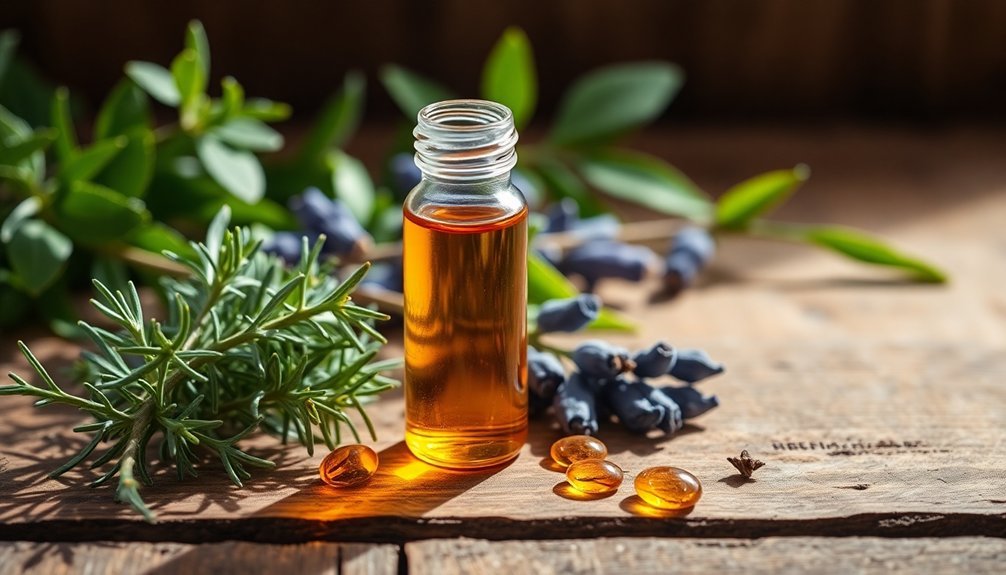
While the term "natural" lacks a standardized definition in the fragrance industry, understanding natural preservatives is vital for both perfume makers and consumers.
You'll need to recognize that natural preservatives in green perfumes often include antioxidants and botanical extracts, though their specific sources may vary. Companies like Abel demonstrate that 100% plant-derived ingredients can create sophisticated fragrances while maintaining product stability.
When you're exploring green perfumes, pay attention to the extraction methods used. Steam distillation and cold pressing are common techniques that help preserve the integrity of natural ingredients while ensuring their safety.
However, you should be aware that even natural preservatives require proper disclosure and concentration control. Since regulatory standards aren't strict, it's important to look for brands that maintain transparency about their ingredients and sourcing methods.
This helps you make informed decisions about the products you're using on your skin.
Essential Plant-Based Preservative Ingredients
Natural perfumes rely on a diverse array of plant-based preservatives to maintain their freshness and stability.
You'll find citric acid, derived from citrus fruits, serving multiple roles – from preserving the formula to preventing ingredient separation and adjusting pH levels.
Plant-derived antimicrobials like tea tree oil and rosemary extract work effectively against bacteria and mold, while natural antioxidants from sources like rooibos protect your perfume's quality.
These ingredients don't just preserve; they often provide additional benefits for your skin and hair. Many brands like Tsi-La Organics use organic sugar cane alcohol as a natural preservative base.
For enhanced protection, you can count on ferulic acid, found in rice and other plants.
When combined with other natural preservatives, it creates a thorough preservation system that keeps your green perfume fresh while maintaining its natural integrity.
Safety Standards for Natural Perfume Preservation
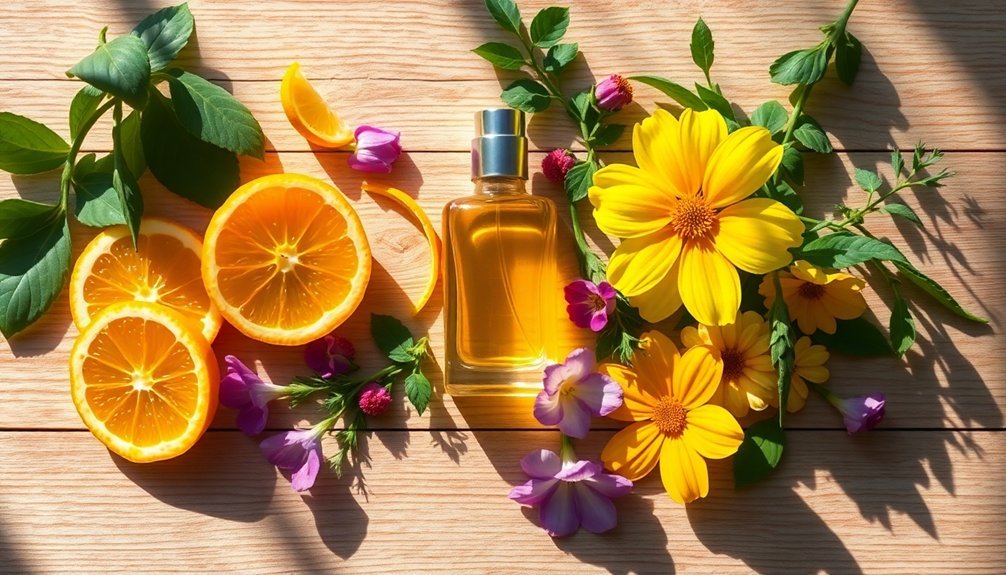
Safety standards for natural perfume preservation follow strict regulatory frameworks established by the International Fragrance Association (IFRA).
You'll need to guarantee your natural perfumes comply with these global standards while avoiding prohibited ingredients like synthetic preservatives, parabens, and phthalates. The standards are backed by four decades of science to ensure safe fragrance creation and use.
The IPF certification process requires transparency and adherence to strict safety protocols, including proper allergen disclosure and patch testing.
- Must use essential oils from certified natural, sustainable sources
- Can't include animal-derived ingredients or conduct animal testing
- Required to follow the New Luxury Code for ethical production
- Need proper storage in dark glass bottles to prevent degradation
- Must maintain full ingredient transparency and avoid vague labeling
These standards help maintain product safety while guaranteeing your natural perfumes remain true to green principles and meet consumer expectations for clean, sustainable fragrances.
Environmental Benefits of Natural Preservative Systems
When you choose natural preservatives for green perfumes, you're supporting a more sustainable future through their biodegradable properties and minimal environmental impact.
You'll find that these preservatives break down safely in the environment, unlike synthetic alternatives that can persist and harm ecosystems.
Your choice also helps conserve natural resources, as these preservatives often come from renewable plant sources and agricultural by-products that would otherwise go to waste.
Biodegradable Impact Assessment
As the beauty industry shifts toward sustainable practices, biodegradable preservative systems in green perfumes have emerged as powerful allies in environmental protection.
You'll find these systems offer significant advantages while meeting regulatory standards and preserving fragrance quality. Companies like Givaudan are leading the charge by developing custom biodegradable solutions that reduce environmental impact without compromising performance.
Key environmental benefits you should know:
- Natural essential oils break down safely in the environment
- Reduced microplastic pollution in water systems
- Lower carbon footprint throughout production process
- Support for biodiversity through ethical sourcing practices
- Minimized waste generation and pollutant release
These preservative systems not only protect your perfume but also align with international safety standards while contributing to a healthier planet.
Natural Resource Conservation
Natural preservative systems in green perfumes deliver substantial environmental advantages through mindful resource conservation.
You'll find these plant-based ingredients are sourced from renewable resources, reducing dependency on non-renewable materials while promoting sustainable farming practices.
When you choose natural preservatives, you're supporting biodiversity conservation as farmers cultivate diverse crops instead of relying on monoculture.
You're also helping minimize carbon emissions since local production reduces transportation needs.
These preservatives don't contribute to greenhouse gas emissions during production and won't disrupt aquatic ecosystems through chemical runoff.
The benefits extend to soil health and ecological balance, as sustainable harvesting practices protect rare species and maintain ecosystem stability.
You'll be participating in a circular economy approach that aligns with fair trade policies and promotes long-term environmental sustainability.
Best Practices for Preserving Botanical Fragrances

The delicate composition of botanical fragrances requires specific storage and handling practices to maintain their quality and longevity.
You'll need to create ideal conditions by keeping your natural perfumes in a cool, stable environment between 15-20°C, away from direct sunlight and heat sources.
Store your fragrances in a dry, climate-controlled area to prevent moisture-related degradation of the botanical ingredients.
- Use a dedicated perfume fridge for precise temperature control
- Keep bottles in their original boxes or dark cabinets to block UV exposure
- Avoid bathroom storage where humidity can compromise fragrance integrity
- Seal bottles properly to minimize air exposure and ingredient evaporation
- Choose a dimly lit storage space, like a bedroom closet or drawer, for long-term preservation
Allergenic Considerations in Natural Preservatives
Understanding potential allergens in natural preservatives should be a top priority when formulating green perfumes. While natural ingredients might seem safer, they can actually be more allergenic than synthetic alternatives. Essential oils like ylang-ylang, jasmine absolute, and citronella can trigger skin reactions and sensitization.
| Natural Preservative | Common Reaction | Safety Consideration |
|---|---|---|
| Essential Oils | Contact Dermatitis | Test low concentrations |
| Botanical Extracts | Skin Sensitization | Check INCI listings |
| Natural Isolates | Pigmented Reactions | Follow EU regulations |
You'll need to be particularly cautious with cinnamon oils and Peru balsam, as they're known allergens. When selecting preservatives, always check the INCI list for potentially allergenic compounds. Consider patch testing before full application, as reactions can range from mild irritation to severe contact urticaria.
Shelf Life Extension With Natural Components
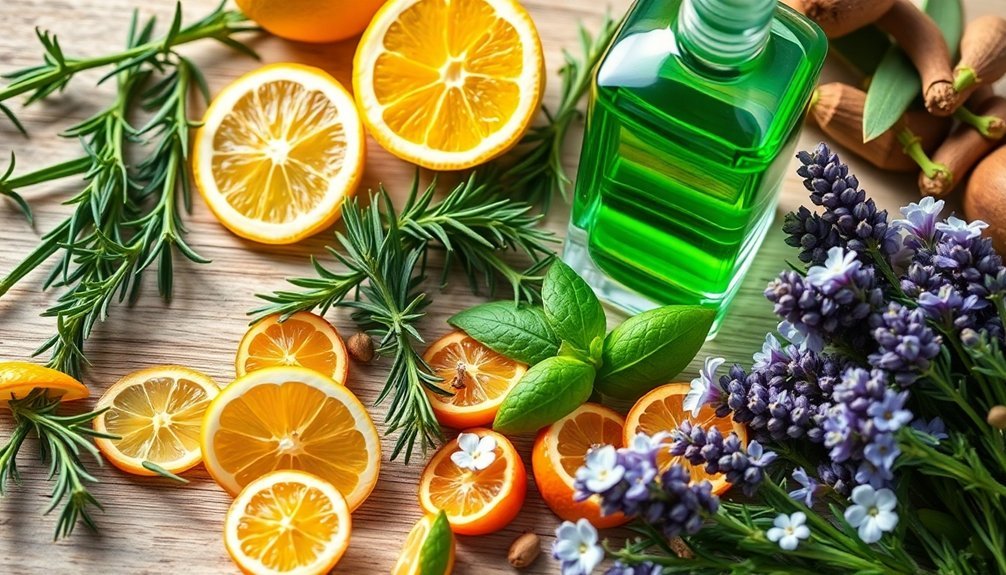
Successfully extending shelf life in green perfumes requires a strategic combination of natural preservatives and protective measures.
You'll need to carefully blend multiple natural preservatives while optimizing their concentrations for maximum effectiveness. By incorporating antioxidants and maintaining proper pH levels, you can enhance the stability of your green perfume formulation.
- Use essential oils like tea tree and lavender for their antimicrobial properties
- Combine different natural preservatives to achieve broad-spectrum protection
- Minimize water content in your formulation to reduce microbial growth risk
- Select appropriate packaging that limits exposure to air and contaminants
- Monitor preservation effectiveness through regular quality control testing
Store your green perfume properly and follow recommended usage guidelines to maintain its integrity.
Remember that while natural preservatives may be gentler than synthetic alternatives, they require more careful formulation to guarantee long-lasting protection.
Sustainable Sourcing of Preservative Materials
Beyond formulating effective natural preservatives, responsible sourcing of these materials forms the backbone of truly sustainable green perfumery.
You'll want to guarantee your preservative ingredients come from suppliers who practice fair trade and maintain transparent supply chains. Look for ingredients certified by recognized standards like ISO 14001:2015 and FSSC 22000.
Choose renewable raw materials and support producers who use sustainable agricultural practices like regenerative farming and agroforestry.
You should avoid ingredients linked to deforestation, such as unsustainable palm oil. Instead, opt for biodegradable preservatives that don't harm the environment when disposed of.
Consider manufacturers who use green energy in their facilities and implement closed-loop water systems. This approach helps protect biodiversity while guaranteeing your natural preservatives truly align with green perfumery principles.
Regulatory Requirements for Green Perfume Preservation
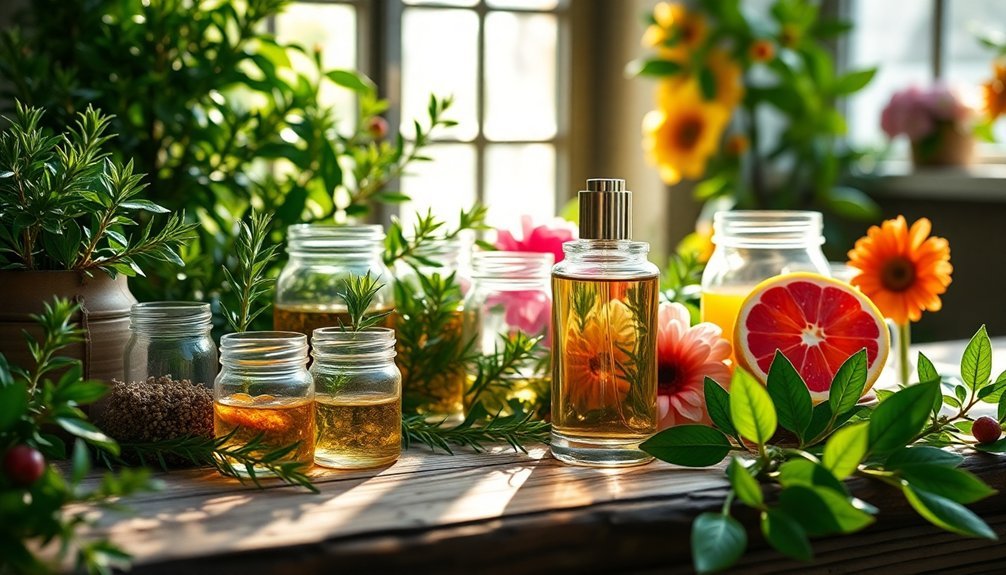
While creating green perfumes requires careful ingredient selection, maneuvering through regulatory requirements demands equal attention.
You'll need to comply with strict environmental regulations, documentation requirements, and certification standards to market your green perfume successfully. The key is ensuring your preservative system meets safety standards while maintaining eco-friendly credentials.
- All ingredients must be disclosed on labels or through dedicated websites for transparency
- Products must undergo regular testing to maintain certifications like Green Seal or EPA's Safer Choice
- Documentation proving preservative dosage and efficacy is mandatory
- Packaging must be environmentally friendly and include proper storage instructions
- Products must meet specific pH standards and VOC limits for environmental safety
Quality Testing and Stability Measures
Quality testing stands at the heart of green perfume development, building upon the regulatory framework with hands-on verification methods.
You'll find that stability testing involves multiple approaches, from accelerated aging in climate chambers to light exposure tests in UV cabinets.
To guarantee your green perfume maintains its integrity, manufacturers use sophisticated tools like spectrophotometers to detect color changes and gas chromatography to measure ingredient retention.
They'll also conduct freeze-thaw cycles to test how your perfume handles temperature extremes.
Natural preservatives like citric acid and sodium benzoate play an essential role in maintaining stability.
When combined with modern fixatives like Polycitronellol, they help your fragrance last longer while keeping it environmentally conscious.
These fixatives can retain both top and middle notes for up to six hours, as confirmed through sensory evaluation panels.
Frequently Asked Questions
Can Natural Preservatives Affect the Original Scent of Green Perfumes?
Yes, natural preservatives can alter your perfume's original scent. You'll notice that some preservatives, especially essential oils and plant extracts, bring their own aromas that might blend with or change your fragrance's character.
How Do Temperature Changes Impact Natural Preservatives During Shipping?
During shipping, you'll find that temperature changes can degrade your natural preservatives, alter fragrance profiles, and trigger unwanted chemical reactions. You'll need proper insulation and cold chain logistics to maintain stability.
Are Natural Preservatives More Expensive Than Synthetic Alternatives?
Yes, you'll find natural preservatives are typically more expensive than synthetic ones due to higher production costs, organic sourcing requirements, and limited availability. However, consumers often accept these costs for health and eco-friendly benefits.
Can I Mix Different Natural Preservatives to Create Custom Preservation Systems?
Yes, you can combine different natural preservatives to create custom systems. You'll need to test for compatibility and stability, but mixing preservatives like sodium benzoate, essential oils, and plant extracts can enhance overall effectiveness.
Do Natural Preservatives Work Differently in Oil-Based Versus Water-Based Perfumes?
Yes, they work very differently. You'll need oil-soluble preservatives for oil-based perfumes and water-soluble ones for water-based formulations. The effectiveness and required concentrations vary between these two types of bases.
In Summary
You've got plenty of options to preserve your green perfumes naturally and safely. Stick to proven ingredients like rosemary extract, vitamin E, grapefruit seed extract, and neem oil. Remember to test your preservation methods carefully, store your fragrances properly, and follow regulatory guidelines. With these natural preservatives, you'll protect your botanical blends while staying true to eco-friendly principles and maintaining product safety.

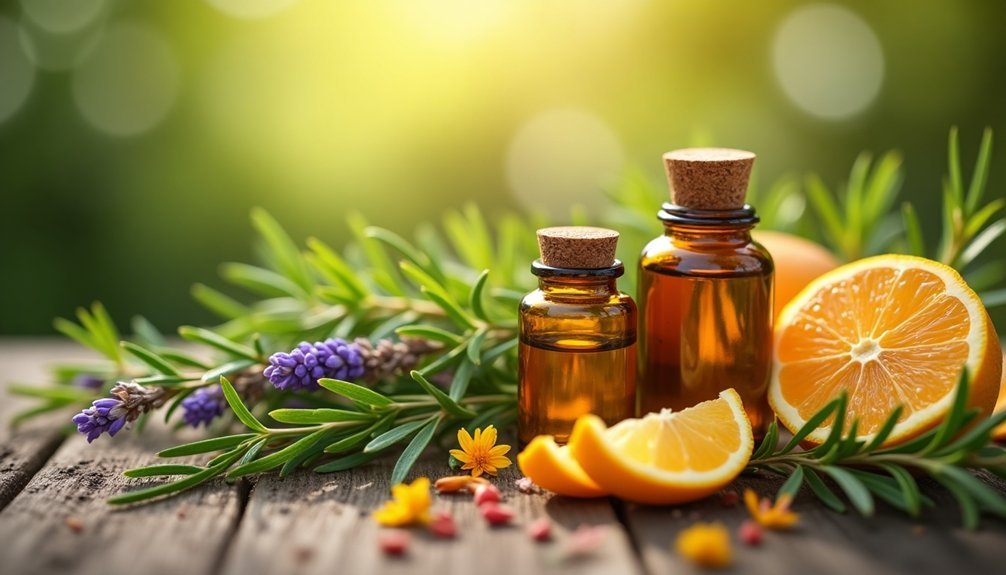



Leave a Reply